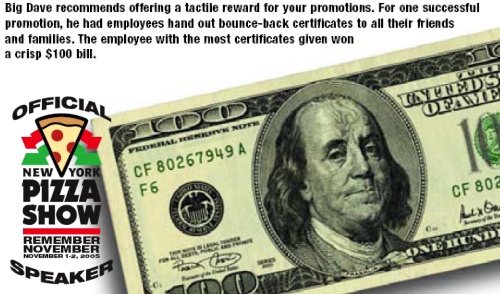In a corporate office of a regional chain, a group of college marketing interns were on the phones. They were conducting a survey of their customers. One of the questions they asked was, “Where have you purchased pizza in the past 30 days besides us?” They input the responses, and the findings were shocking to them. We spread out the printouts and did the count. I’ve known this chain for over 30 years and they have branded themselves on quality. They are known for miles around for their excellent, high quality pizzas.
When the counting was done, one unlikely competitor stood out and had stolen dozens of their customers. In this case it was Little Caesars. In your town it might be Costco, Pizza Hut, Papa Murphy’s, Domino’s or Papa John’s. Regardless, many of the big players are dropping price to snag your customers. Why would one or possibly hundreds of satisfied customers jump ship and cheat on you? Three little words: speed, price and convenience.
My wife, who is in charge of getting dinner for my four sons, opts for Little Caesars on a regular basis. She works five days a week and is taking graduate classes on weekends. Time is the one thing she can’t buy or create. On any given day, my boys are into after-school activities. The problem: feed them pronto. The solution: A grab-it-and-go family favorite, pizza. Never said the pizza was great, just ready.
If you check out my garbage bags, you’d find more than a few Little Caesars empty boxes. What is the real deal on Little Caesars? I get puzzled questions like this weekly. Here are my findings. The organization has had its ups and downs. Right now, it's the biggest kept secret on the planet. For the last three years, Little Caesars has grown double digits every year. Since it's a privately held company, you won't see audited financials.
A typical LC store grosses $14-$15K a week. Food cost (including pizza box) runs 36 – 40 percent. They have the cost per unit down to within pennies a pie…do you? Labor has been shaved down to 18-19 percent with 22 percent being the high side. The staff only has to master a few tasks The are required to make hundreds of 14-inch cheese and pepperoni pies an hour, run the counter and phones with a smile, never run out of dough or cheese and never, never ever not have “Hot & Ready” pizzas in the warmer. Most customers will not wait for a Hot & Ready. You run out; they walk out. Some will still wait five to six minutes and some still order (20 percent) custom-made pizzas.
“Hot & Ready” accounts for 80 percent of total sales. Pepperoni pizzas outsell cheese pizzas seven to one. Crazy Bread (great food cost) accounts for 5 (without asking) to 10 percent of sales, if it's suggestively sold and if it's ready.
One hundred percent of company stores have abandoned home delivery. The high cost of delivery sucked profit from the stores. Many franchisees have, or are about to discontinue delivery. The history of the chain has been: provide the biggest bang for the buck to pizza eaters. They successfully accomplished this in the 80s with “Pizza Pizza” and have simply reengineered the brand 20 years later with the “Hot & Ready” concept.
Little Caesars has evolved from a neighborhood pizza place to a QSR (quick service restaurant) concept. Limited choices, great price point and the most important component: ZERO WAIT TIME. I can't stress this enough. The customer walks in, lays down their money and the customer walks out in 30 seconds. For that time-saving consideration, they are quite comfortable in buying a cookie-cutter, generic pizza. Current trends in today's society say the fastest wins. People can't buy time. Think McDonald’s.
This pizza has high quality cheese (mozzarella/muenster blend). I know the dairy. It’s the same one I bought my cheese from. They use fresh-made dough, average sauce and Hormel or above pepperoni. The portion sizes are at or above national averages: eight to nine ounces of cheese and 30 thin slices of pepperoni.
If you know my story, you might remember the “words of wisdom” my step dad gave me when I was young in the business. His quote was: "Make the highest quality or the lowest cost pizza you can. You'll always have lots of customers. If you make a middle of the road pizza, the high quality places will pull your customers up and away and the lowest cost places will pull your customers down and away." These words gave me direction every time I made decisions on pricing, ingredients and profitability for my 30 plus years as an owner operator.
My banker never once in 30 years complimented me on my food cost. The only thing he laser-focused on was the bottom line: cash flow, profitability and ability to service debt. It looks like Little Caesars has perfected their prime costs (combination of food and labor percentage) to right around 55 – 60 percent. Couldn't be better. When cheese is below $1.80 a pound they are making money, cash, moolah, dinero, hand over fist.
If you really want to compete against them you only have one or two choices to make: Meet and beat them at there own game… ie; $4.99 grab-n-go pizza, or position your pizza place as the undisputed best of the best in your town. This strategy is the one I chose. Some of it was due to my ego and sense of pride, and the other was I was consistently profitable.
But, in order to do this, I had to mold myself into a guerilla marketer (lots of trial and error – years of research and study) and from time-to-time run offers that beat my competition's best shot. I accepted any coupon printed from anywhere in the world as well as had a 29 minute or free delivery (sorry Domino's) time. These ploys worked. We enjoyed 65 –70 percent market share in my zip code. But we earned it every day and never took the customer's loyalty for granted.
Little Caesars has successfully positioned and branded themselves as the undisputed “lowest cost provider” of pizza in the USA. It is working well for them. It wasn't a decision made from desperation, rather than a well thought out experiment that had turned to gold.
I predict that they will outsell Papa John's this year on sales per store average, but we'll never know because the books are not open for comparison.
I assure you they want to keep all of us thinking they are just feeding the bottom feeders, and are out of their mind as they laugh all the way to the bank.
If you want to hear more about my ways to blow the competition out of the water, come to my seminar at the New York Pizza Show, November 1-2, 2005 in New York City.
















